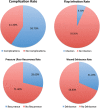Flap Reconstruction for Pressure Ulcers: An Outcomes Analysis
- PMID: 28203494
- PMCID: PMC5293292
- DOI: 10.1097/GOX.0000000000001187
Flap Reconstruction for Pressure Ulcers: An Outcomes Analysis
Abstract
Background: Historically, complication rates after pressure ulcer reconstruction utilizing flap coverage have been high. Patients undergoing operations for pressure ulcer coverage typically have multiple risk factors for postoperative complications. The purpose of this study was to examine a large patient series in the pressure ulcer population to uncover objective evidence of the linkage between risk factors and outcomes after flap coverage.
Methods: This study was a retrospective chart review of patients who underwent flap reconstruction for a pressure ulcer between 1997 and 2015. The characteristics of patients were analyzed to determine those who had complications such as pressure ulcer recurrence, wound dehiscence, and wound infection.
Results: All patients (N = 276) underwent flap coverage of their pressure ulcers. The overall complication rate was 58.7% (162 patients). Wound dehiscence was the most common complication (31.2%), and the pressure ulcer recurrence rate was 28.6%. Multivariate regression for pressure ulcer recurrence revealed that body mass index <18.5 [relative risk (RR) 3.13], active smoking (RR 2.33), and ischial pressure ulcers (RR 3.46) were independent risk factors for pressure ulcer recurrence. Ischial pressure ulcers (RR 2.27) and preoperative osteomyelitis (RR 2.78) were independent risk factors for wound dehiscence. Diabetes was an independent risk factor for wound infection (RR 4.34).
Conclusions: Our retrospective analysis revealed numerous factors that are associated with high rates of major postoperative complications. Risk factors must be taken into account when offering flap coverage, and risk-reducing strategies must be implemented in patients before pressure ulcer reconstruction.
Similar articles
-
Multivariate predictors of failure after flap coverage of pressure ulcers.Plast Reconstr Surg. 2010 Jun;125(6):1725-1734. doi: 10.1097/PRS.0b013e3181d51227. Plast Reconstr Surg. 2010. PMID: 20517098
-
A retrospective study: Multivariate logistic regression analysis of the outcomes after pressure sores reconstruction with fasciocutaneous, myocutaneous, and perforator flaps.J Plast Reconstr Aesthet Surg. 2017 Aug;70(8):1038-1043. doi: 10.1016/j.bjps.2017.04.004. Epub 2017 Apr 23. J Plast Reconstr Aesthet Surg. 2017. PMID: 28552279
-
National perioperative outcomes of flap coverage for pressure ulcers from 2005 to 2015 using American College of Surgeons National Surgical Quality Improvement Program.Arch Plast Surg. 2018 Sep;45(5):418-424. doi: 10.5999/aps.2018.00262. Epub 2018 Sep 15. Arch Plast Surg. 2018. PMID: 30282412 Free PMC article.
-
Use of antibiotic impregnated resorbable beads reduces pressure ulcer recurrence: A retrospective analysis.Wound Repair Regen. 2018 Mar;26(2):221-227. doi: 10.1111/wrr.12638. Wound Repair Regen. 2018. PMID: 29770531 Free PMC article.
-
[Reconstruction using the tensor fasciae latae muscle flap].Oper Orthop Traumatol. 2018 Aug;30(4):228-235. doi: 10.1007/s00064-018-0556-6. Epub 2018 Jun 27. Oper Orthop Traumatol. 2018. PMID: 29951749 Review. German.
Cited by
-
Biofabrication of thick vascularized neo-pedicle flaps for reconstructive surgery.Transl Res. 2019 Sep;211:84-122. doi: 10.1016/j.trsl.2019.05.003. Epub 2019 May 21. Transl Res. 2019. PMID: 31170376 Free PMC article. Review.
-
The niche of dermal graft to reconstruct a complex pressure injury wound in sacral region: A case report.Medicine (Baltimore). 2023 Dec 22;102(51):e36617. doi: 10.1097/MD.0000000000036617. Medicine (Baltimore). 2023. PMID: 38134078 Free PMC article.
-
Retrospective analysis of the management of pelvic decubitus ulcers and their outcomes.Ther Adv Infect Dis. 2023 Sep 6;10:20499361231196664. doi: 10.1177/20499361231196664. eCollection 2023 Jan-Dec. Ther Adv Infect Dis. 2023. PMID: 37693861 Free PMC article.
-
Risk Factors for Postoperative Complications among the Elderly after Plastic Surgery Procedures Performed under General Anesthesia.Plast Surg Int. 2018 Jul 8;2018:7053839. doi: 10.1155/2018/7053839. eCollection 2018. Plast Surg Int. 2018. PMID: 30112200 Free PMC article.
-
Management of a Recurrent Ischial Sore Using a 3-Flap Technique.Arch Plast Surg. 2017 Jul;44(4):351-352. doi: 10.5999/aps.2017.44.4.351. Epub 2017 Jul 15. Arch Plast Surg. 2017. PMID: 28728336 Free PMC article. No abstract available.
References
-
- Lyder CH. Pressure ulcer prevention and management. JAMA. 2003;289:223–226. - PubMed
-
- Reddy M, Gill SS, Rochon PA. Preventing pressure ulcers: a systematic review. JAMA. 2006;296:974–984. - PubMed
-
- Russo CA, Steiner C, Spector W. Hospitalizations Related to Pressure Ulcers, 2006. Rockville, MD:: Agency for Healthcare Research and Quality; 2008. Dec, HCUP Statistical Brief #64. Available at: http://www.hcup-us.ahrq.gov/reports/statbriefs/sb64.pdf. - PubMed
-
- Preventing Pressure Ulcers in Hospitals. Rockville, MD:: Agency for Healthcare Research and Quality; September 2012 (content last reviewed October 2014). Available at: http://www.ahrq.gov/professionals/systems/hospital/pressureulcertoolkit/.... Accessed June 1, 2016.
-
- Filius A, Damen TH, Schuijer-Maaskant KP, et al. Cost analysis of surgically treated pressure sores stage III and IV. J Plast Reconstr Aesthet Surg. 2013;66:1580–1586. - PubMed
Grants and funding
LinkOut - more resources
Full Text Sources
Other Literature Sources

